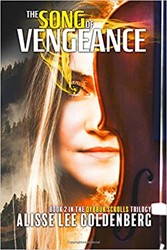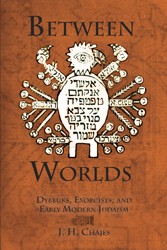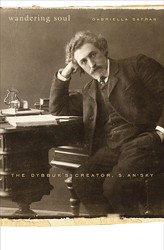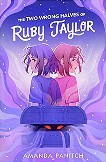By
– August 3, 2012
Passionate is the best word to describe Rogasky’s telling and Fisher’s illustrating of this classic Jewish tale of possession. It is based on S. Y. Ansky’s famous play, The Dybbuk: Between Two Worlds and is the story of two young lovers who are united supernaturally, when the tormented spirit of the rejected suitor, Konin, enters the body of his beloved, Leah, whose father, Reb Sender, would not allow them to be married. In his rejection of Konin, Reb Sender breaks a vow that he made years ago to his then good friend, Konin’s father: that if one of them had a son and the other a daughter, the two children would be married. Having forgotten his friend and his vow, Reb Sender seeks wealth for Leah and not a poor, orphaned scholar like Konin. When he realizes this, Konin turns from prayer and study to Kabbalah, and from Kabbalah to the dark powers, which eventually kill him. Leah breaks with custom and visits the cemetery on the day she is to be married, inviting Konin’s wandering spirit to come to her wedding. All of these transgressions — against God, against faith, against tradition — and their consequences play out in a Hasidic community that, despite rabbinical intervention, a ghostly trial, and an exorcism, cannot prevent the spirits of Konin and Leah from merging as one in death. The dialogue between Konin and Leah is memorable in its intensity and the narrative style, which directly addresses the reader at critical, often transitional moments, is mesmerizing. As suspense builds, the full page or double page illustrations powerfully capture action, character and setting. Rogasky’s writing and Fisher’s art are made for one another; in all of their books, a few for the author and many for the artist, there is an elemental quality that finds full expression in this tale. Children in the upper elementary grades, especially if The Dybbuk is read to them episodically, will be thrilled by the ghost story they are hearing; older readers will find the story provocative and perplexing, fulfilling the narrator’s introductory words: “Exactly what that lesson is, I’m not sure about myself.” Like other literature that probes human emotions and actions at their most elemental level, this version of The Dybbuk will linger in the hearts and minds of its readers. Highly recommended for ages 11 and up.
Linda R. Silver is a specialist in Jewish children’s literature. She is editor of the Association of Jewish Libraries’ Jewish Valuesfinder, www.ajljewishvalues.org, and author of Best Jewish Books for Children and Teens: A JPS Guide (The Jewish Publication Society, 2010) and The Jewish Values Finder: A Guide to Values in Jewish Children’s Literature (Neal-Schuman, 2008).





